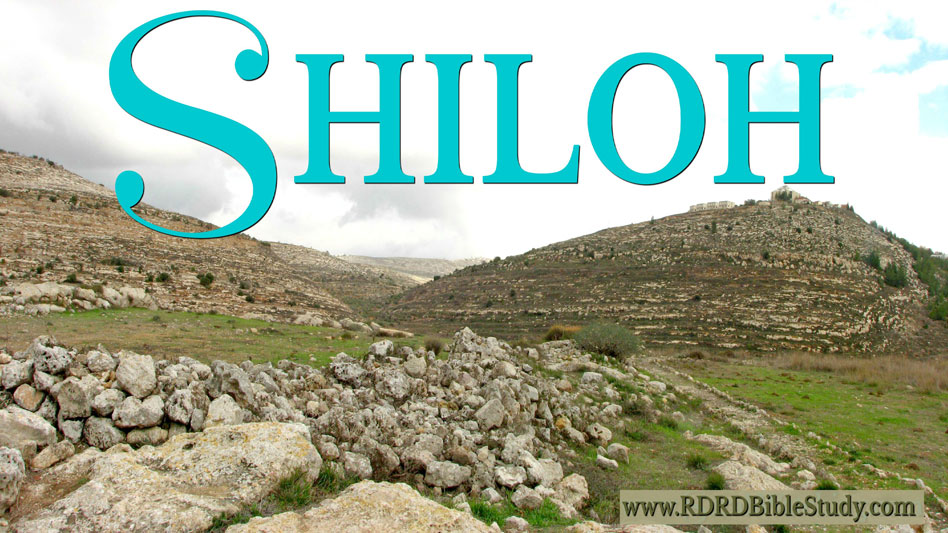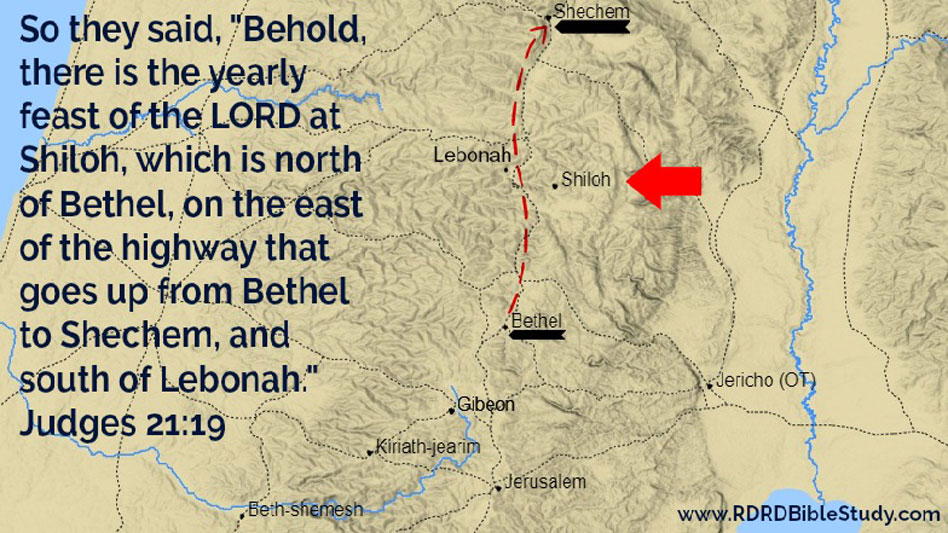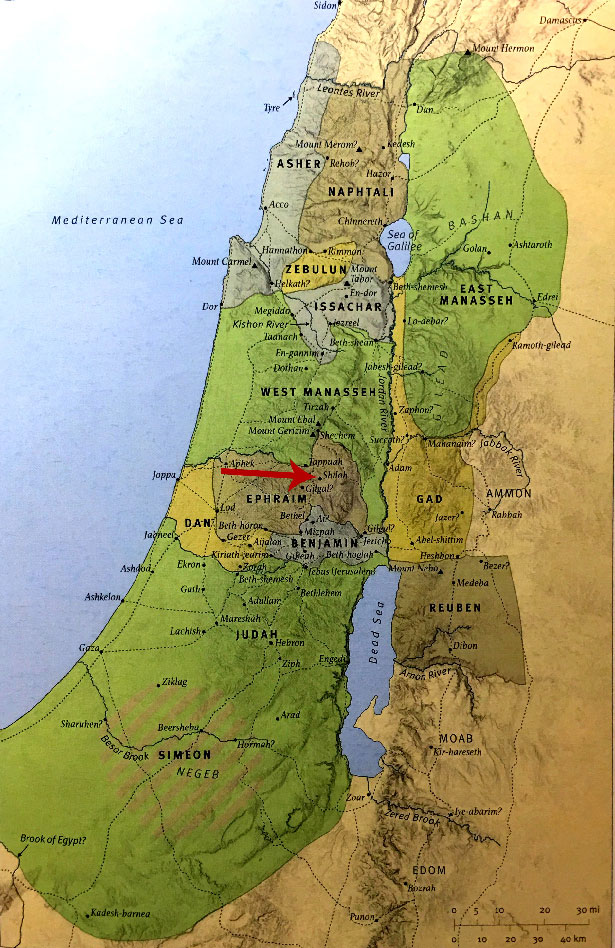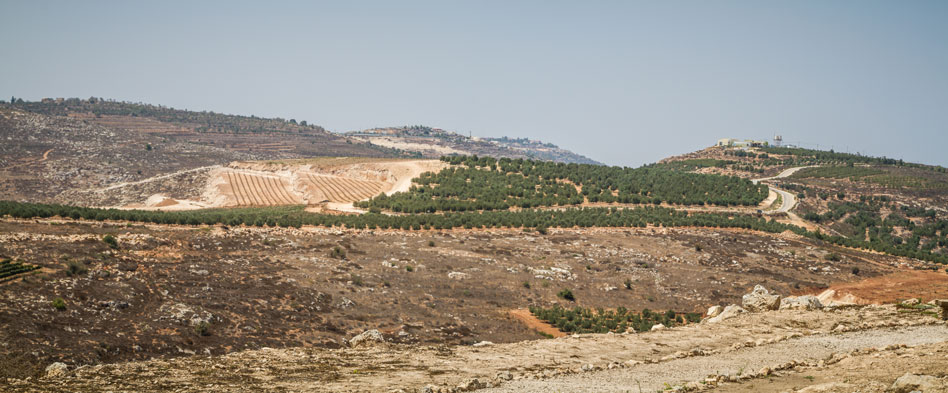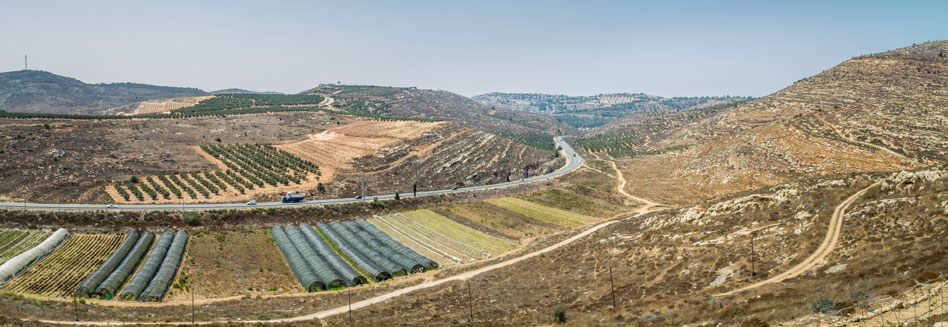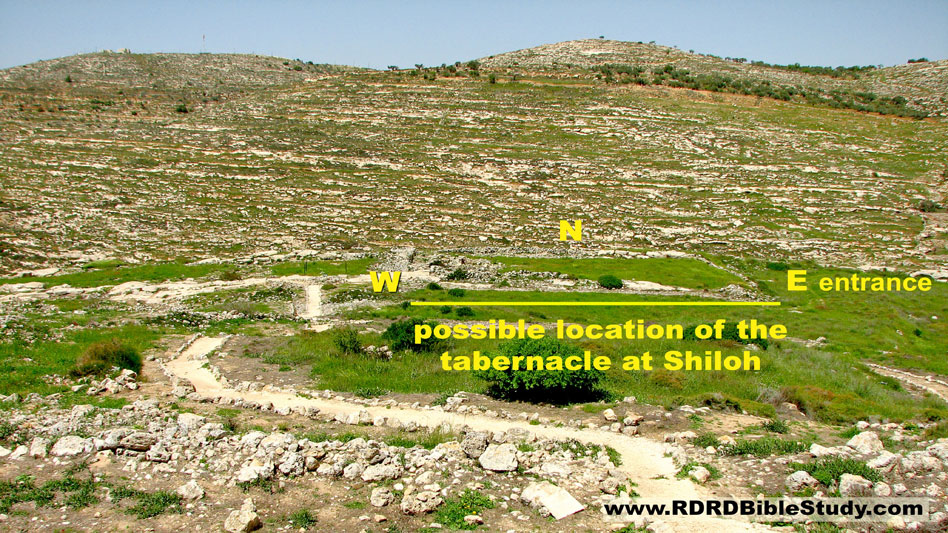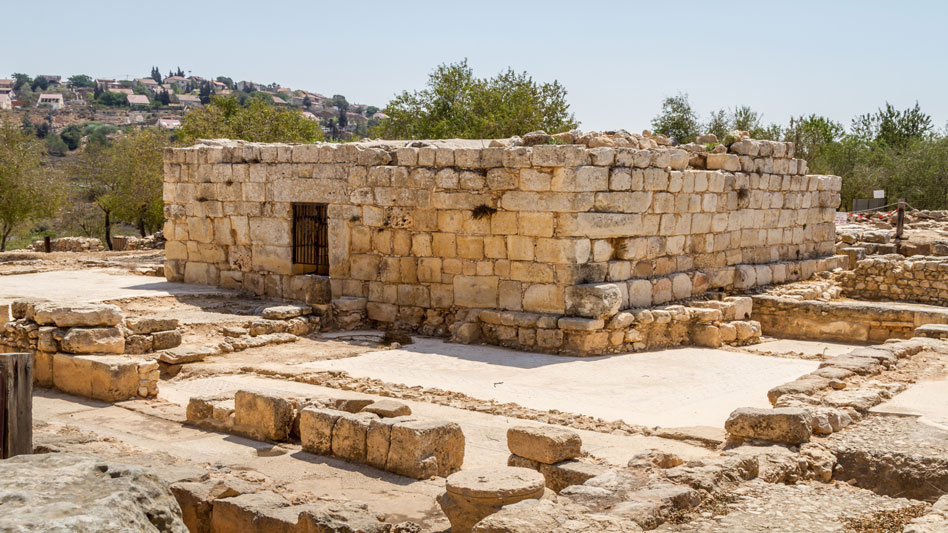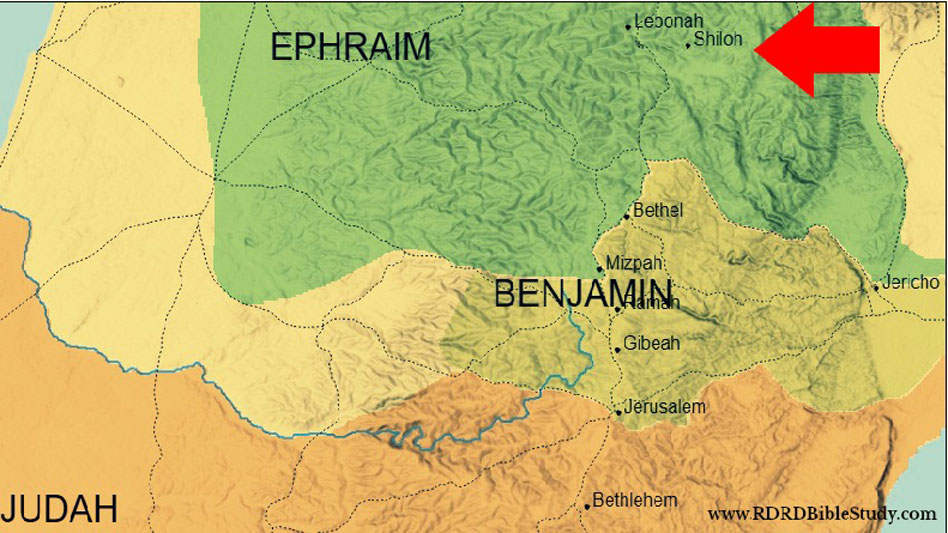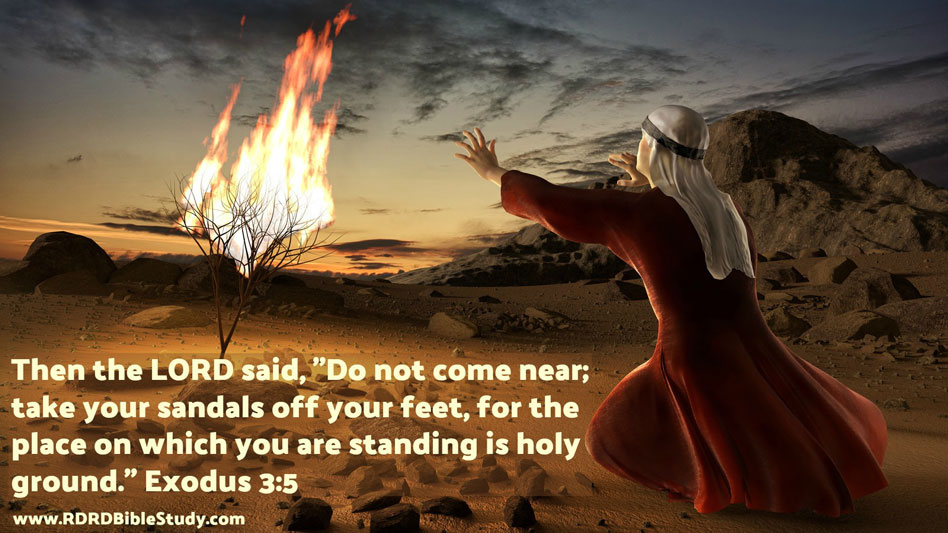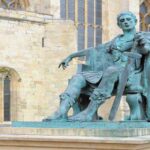Shiloh
Introduction
Shiloh (pronounced shee-loh) is an ancient Israelite city that served as the central sanctuary from the days of Joshua, through the period of the Judges, and until Samuel’s time. Shiloh functioned as both a religious capital and military operations base for the tribes during the settlement period.
At Shiloh the Israelites set up the Tabernacle—the Tent of Meeting constructed at the beginning of the wilderness journey and after forty years brought into the Promised Land (Joshua 18:1, 8-10; 21:2). According to Talmudic sources, the Ark remained at Shiloh for 369 years. Other scholars estimate anywhere between 200-400 years. The area was well suited as a quiet place for worship, surrounded by hills, pasture lands, and a water supply.
Shiloh was a city in the tribal territory of Ephraim. Judges 21:19 describes its position with exactitude:
So they said, “Behold, there is the yearly feast of the LORD at Shiloh, which is north of Bethel, on the east of the highway that goes up from Bethel to Shechem, and south of Lebonah.” Judges 21:19
This location is 20 miles north and slightly east of Jerusalem.
The location of biblical Shiloh has been known from the Middle Ages. It is near the modern site known as Khirbet Seilun. Bishop, scholar, and church historian Eusebius (c. AD 260-340) notes that Shiloh was twelve miles from Shechem (Onomasticon 156, 28).
Meaning Of Shiloh In The OT
Shiloh is simply defined as a place name in various Hebrew dictionaries.
HALOT notes that “in Hebrew the original form of this name would probably have been Šīlōn (shee-lon, “lon” rhymes with “own”).
The Hebrew consonants s-l-h (the place name does not end with the silent “h”) have noun and adjective cognates that mean “peace, quiet, or rest.” It is possible that the name “Shiloh” could be related to s-l-h because God Himself promised to direct them to a place that He would choose to make His Name dwell:
“You shall not do according to all that we are doing here today, everyone doing whatever is right in his own eyes, 9 for you have not as yet come to the rest and to the inheritance that the LORD your God is giving you. 10 But when you go over the Jordan and live in the land that the LORD your God is giving you to inherit, and when he gives you rest from all your enemies around, so that you live in safety, 11 then to the place that the LORD your God will choose, to make his name dwell there, there you shall bring all that I command you: your burnt offerings and your sacrifices, your tithes and the contribution that you present, and all your finest vow offerings that you vow to the LORD. Deuteronomy 12:8-11
Matthew Henry makes the comment “And Dr. Lightfoot thinks that the place where the tabernacle was set up was therefore called Shiloh, because of the peaceableness of the land at this time; as afterwards in Salem was his temple, which also signifies peaceable” (Matthew Henry Commentary on Joshua 18:1).
Layout of the Land
Location of Shiloh within the nation of Israel;
Bible Study tip: To remember where a city or region is located, in this instance Shiloh, make a mental and visual note of it in relation to the location of Jerusalem and Gilgal (traditional Gilgal slightly west of the Jordan River).
Israel’s central mountain region, or hill country, extends all the way down from the mountains of Lebanon in the north. The western terrain rises sharply from the plains to these hills, a notable change for anyone driving from Tel Aviv to Jerusalem. The central range of mountains may be divided into sub-sections. From north to south these are Galilee, Samaria, Judea, and the Negev.
Shiloh was located in the hill country of Samaria within the tribal allotment of Ephraim. The Hills of Samaria are also known as “Mount Ephraim,” named after the Israelite tribe that settled in the southern part of it (Joshua 16). Ephraim and Manasseh, both sons of Joseph, settled in its northern part (Joshua 17; ½ of Manasseh settled east of the Jordan).
When the northern kingdom made its capital in Samaria the region became known as Samaria also. While reading the Bible, keep in mind that Samaria may refer to the city or the region. Much of this region today is known as the West Bank.
Shiloh In The Heart Of The Country
Shiloh was in the heart of the country, nearer the center than Jerusalem. Setting up the Tabernacle there would be more convenient for the meeting of all Israel as the people traveled from multiple parts of the country. During the desert sojourn the Tabernacle had been in the middle of the camp, and now it would be located in the middle of the nation. Also, Joshua, the leader of the people, belonged to the tribe of Ephraim (1 Chron. 7:27). It would have been for his honor and convenience as well as the advantage of the country to have it near him.
Rural landscape and farmland of settlement Shiloh. These three panoramic views are from the vantage point of the archaeological park of Shiloh. You can see it is a beautiful setting for a sanctuary.
Let the heavens praise your wonders, O LORD, your faithfulness in the assembly of the holy ones! Psalm 89:5
History
The Bible records both worship and other theocratic activities requiring priestly mediation occurring at Shiloh.
- This site is where Joshua and Eleazar the priest (son of Aaron) inquired of God regarding tribal inheritance of the land (Joshua 18:1-7).
- From here Joshua allotted the land west of the Jordan to the 9 ½ tribes (Joshua 18:8-19:51), designated cities of refuge (Joshua 20), and allotted cities to the Levites (Joshua 21).
- The high priest Eli and his reprobate sons served at Shiloh—the first hint of the severity of spiritual problems plaguing the priesthood (1 Samuel 2:12-17, 27-36).
- When Elkanah went up to Shiloh to worship and sacrifice, his wife Hannah prayed for a child (1 Samuel 1:1-19).
- God answered Hannah’s prayer with a son whom she named Samuel (1 Samuel 1:20).
- Later Samuel is called by God while serving at the Tabernacle under Eli (1 Samuel 3).
- After the Jerusalem temple was destroyed by Nebuchadnezzar’s army, the people came to Shiloh to offer sacrifices (Jere. 41:5).
Shiloh is believed by researchers to have fallen into ruin after the Israelites’ unsuccessful war with the Philistines, in which the enemy took the Holy Ark captive (1 Samuel 4). The Ark was soon returned to Israel, but was never brought back to Shiloh. Instead, it was taken to Kiriath-jearim until King David had it delivered to Jerusalem (1 Samuel 7:2).
Biblical References
Historical Narratives
After the conquest of the land the Tabernacle is set up at Shiloh.
Joshua 18:1 Then the whole congregation of the people of Israel assembled at Shiloh and set up the tent of meeting there. The land lay subdued before them.
Being the place where God dwelled, here the people cast lots for the tribal allotments.
Joshua 18:8-10 So the men arose and went, and Joshua charged those who went to write the description of the land, saying, “Go up and down in the land and write a description and return to me. And I will cast lots for you here before the LORD in Shiloh.” (9) So the men went and passed up and down in the land and wrote in a book a description of it by towns in seven divisions. Then they came to Joshua to the camp at Shiloh, (10) and Joshua cast lots for them in Shiloh before the LORD. And there Joshua apportioned the land to the people of Israel, to each his portion.
Completion of the allotments.
Joshua 19:51 These are the inheritances that Eleazar the priest and Joshua the son of Nun and the heads of the fathers’ houses of the tribes of the people of Israel distributed by lot at Shiloh before the LORD, at the entrance of the tent of meeting. So they finished dividing the land.
The heads of the fathers’ house of the tribe of Levi inquire about the cities to be allotted to the Levites.
Joshua 21:2 And they said to them at Shiloh in the land of Canaan, “The LORD commanded through Moses that we be given cities to dwell in, along with their pasturelands for our livestock.”
Possible site of the Tabernacle in Shiloh. The stones in the feature image’s foreground are the bedrock cuttings seen in the southwest corner above.
Reuben, Gad, and the half-tribe of Manasseh depart Shiloh to return to their inheritance to the east of the Jordan.
Joshua 22:9 So the people of Reuben and the people of Gad and the half-tribe of Manasseh returned home, parting from the people of Israel at Shiloh, which is in the land of Canaan, to go to the land of Gilead, their own land of which they had possessed themselves by command of the LORD through Moses.
The tribes of Reuben, Gad, and the half-tribe of Manasseh build an altar at the Jordan. The rest of the tribes misunderstood its purpose and met at Shiloh to wage war against them. This is an example of Shiloh’s use as a military base.
Joshua 22:12 And when the people of Israel heard of it, the whole assembly of the people of Israel gathered at Shiloh to make war against them.
Reference to the House of God at Shiloh as a time notation for the Danites’ corrupt worship practices.
Judges 18:31 So they set up Micah’s carved image that he made, as long as the house of God was at Shiloh.
The following verses references a yearly feast held at Shiloh.
Judges 21:12 And they found among the inhabitants of Jabesh-gilead 400 young virgins who had not known a man by lying with him, and they brought them to the camp at Shiloh, which is in the land of Canaan.
Judges 21:19 So they said, “Behold, there is the yearly feast of the LORD at Shiloh, which is north of Bethel, on the east of the highway that goes up from Bethel to Shechem, and south of Lebonah.”
Judges 21:21 and watch. If the daughters of Shiloh come out to dance in the dances, then come out of the vineyards and snatch each man his wife from the daughters of Shiloh, and go to the land of Benjamin.
“This man” is Hannah’s husband, Elkanah. That he is devout is known because he “used to go up year by year from his city to worship and to sacrifice to the LORD…”. The mention of the priestly family of Eli names the priests serving the Lord at that time setting up the narrative showcasing their direct role in the defeat by the Philistines and the capture of the Ark. The verse also contrasts righteous Elkanah and the reprobate sons of Eli, exposing the spiritual decline of the priests and by default, the nation.
1 Samuel 1:3 Now this man used to go up year by year from his city to worship and to sacrifice to the LORD of hosts at Shiloh, where the two sons of Eli, Hophni and Phinehas, were priests of the LORD.
Hannah, who also went to worship, prays to the LORD for a child.
1 Samuel 1:9 After they had eaten and drunk in Shiloh, Hannah rose. Now Eli the priest was sitting on the seat beside the doorpost of the temple of the LORD.
Hannah promised that if God gave her a son, she would give him to the service of the LORD. Keeping her vow, she takes Samuel to Shiloh.
1 Samuel 1:24 And when she had weaned him, she took him up with her, along with a three-year-old bull,1 an ephah2 of flour, and a skin of wine, and she brought him to the house of the LORD at Shiloh. And the child was young.
1 Samuel 2:12 says “Now the sons of Eli were worthless men. They did not know the LORD. The following verses detail their failure to carry out the sacrificial rituals as God had instructed Moses. Verse 14’s “at Shiloh” intimates they did this to all the worshippers who came to sacrifice.
1 Samuel 2:14 and he would thrust it into the pan or kettle or cauldron or pot. All that the fork brought up the priest would take for himself. This is what they did at Shiloh to all the Israelites who came there.
The Lord speaks to Samuel.
1 Samuel 3:21 And the LORD appeared again at Shiloh, for the LORD revealed himself to Samuel at Shiloh by the word of the LORD.
After being defeated by the Philistines during one skirmish, the fighting men of Israel agree to take the Ark of the Covenant from the tabernacle at Shiloh into battle “to save us from the power of our enemies.” Eli’s two “worthless” sons are with the ark. Based on the previous narrative, this is a microcosm of the greater danger faced by the nation when the things of God are treated with contempt. When Jeremiah references Shiloh as a warning for Jerusalem, it is this type of behavior—forsaking God and putting faith in an object—that he condemns.
1 Samuel 4:3-4 And when the troops came to the camp, the elders of Israel said, “Why has the LORD defeated us today before the Philistines? Let us bring the ark of the covenant of the LORD here from Shiloh, that it may come among us and save us from the power of our enemies.” (4) So the people sent to Shiloh and brought from there the ark of the covenant of the LORD of hosts, who is enthroned on the cherubim. And the two sons of Eli, Hophni and Phinehas, were there with the ark of the covenant of God.
A messenger runs to Shiloh with news from the battle.
1 Samuel 4:12 A man of Benjamin ran from the battle line and came to Shiloh the same day, with his clothes torn and with dirt on his head.
Eli’s grandson, Ahijah the priest, is with Saul and his army during a battle with the Philistines. The phrase “wearing an ephod” reminds the reader that the Ark of the Covenant is not at the house of God in Shiloh where it should be.
1 Samuel 14:3 including Ahijah the son of Ahitub, Ichabod’s brother, son of Phinehas, son of Eli, the priest of the LORD in Shiloh, wearing an ephod. And the people did not know that Jonathan had gone.
Ruins of an ancient synagogue in the archaeological park of Shiloh in Israel.
Through Samuel, God prophesied that the priesthood would be taken away from the family of Eli. Here the prophecy is fulfilled through Solomon.
1 Kings 2:27 So Solomon expelled Abiathar from being priest to the LORD, thus fulfilling the word of the LORD that he had spoken concerning the house of Eli in Shiloh.
King Jeroboam sends his wife to Shiloh to speak with Ahijah the prophet. In other verses, Ahijah is referred to as a “Shilonite” (1 Kings 11:29, 12:15, 15:29; 2 Chronicles 9:29, 10:15).
Note that Jeroboam I, the first king of the Northern Kingdom, sends his wife to Shiloh (inquiring about their sick son Abijah). Prior to this, Jeroboam had established worship centers in Bethel and Dan by setting up golden calves at each place, to prevent the people from going to the temple in Jerusalem.
1 Kings 14:2 And Jeroboam said to his wife, “Arise, and disguise yourself, that it not be known that you are the wife of Jeroboam, and go to Shiloh. Behold, Ahijah the prophet is there, who said of me that I should be king over this people.
1 Kings 14:4 Jeroboam’s wife did so. She arose and went to Shiloh and came to the house of Ahijah. Now Ahijah could not see, for his eyes were dim because of his age.
Shilonites are listed among the people who lived in Jerusalem upon return from the Babylonian exile in both the books of Chronicles and Nehemiah.
1 Chronicles 9:5 And of the Shilonites: Asaiah the firstborn, and his sons.
Nehemiah 11:5 and Maaseiah the son of Baruch, son of Col-hozeh, son of Hazaiah, son of Adaiah, son of Joiarib, son of Zechariah, son of the Shilonite.
Psalms
The Psalmist writes poetically of God forsaking Shiloh.
Psalm 78:60 He forsook his dwelling at Shiloh, the tent where he dwelt among mankind.
Prophets
Jeremiah 7 and 26, the famous “temple sermon” uses Shiloh as an analogy of what God will do to Jerusalem—“as he did to Shiloh”—if they do not repent and turn from their sin. For more info, see Biblical Observations below.
Jeremiah 7:12 Go now to my place that was in Shiloh, where I made my name dwell at first, and see what I did to it because of the evil of my people Israel.
Jeremiah 7:14 therefore I will do to the house that is called by my name, and in which you trust, and to the place that I gave to you and to your fathers, as I did to Shiloh.
Jeremiah 26:6 then I will make this house like Shiloh, and I will make this city a curse for all the nations of the earth.'”
Jeremiah 26:9 Why have you prophesied in the name of the LORD, saying, ‘This house shall be like Shiloh, and this city shall be desolate, without inhabitant’?” And all the people gathered around Jeremiah in the house of the LORD.
Shortly after the fall of Jerusalem at the hands of the Babylonians, men in mourning from the surrounding area bring sacrifices to present at the Jerusalem temple.
Jeremiah 41:5 eighty men arrived from Shechem and Shiloh and Samaria, with their beards shaved and their clothes torn, and their bodies gashed, bringing grain offerings and incense to present at the temple of the LORD.
Archaeological
Archaeological excavations have shown that Shiloh was destroyed around 1050 B.C., apparently by the Philistines at the time they captured the ark of the covenant (1 Sam 4; cf Ps. 78:60; Jer 7:12, 14; Jer 26:6, 9).
The mound identified with Shiloh is oval in shape, covering an area of approximately 8.5 acres (35 dunams).
The top level of the area yielded ruins from the crusader settlement which was destroyed by Saladin. Beneath that were Byzantine ruins, Hellenistic ruins, and houses and walls that dated to the Iron Age I period. There are some traces of occupation in the Middle Bronze Period (c 2100 – 1600 BC). No evidence of Canaanite occupation was found for the Late Bronze Period (c 1600 – 1200 BC).
The Iron Age I period beginning about 1200 BC and continuing to about 1050 BC would have been during the time of Eli and Samuel.
The Israelites were evidently the first to build extensively at this site. Evidence of a city wall, a synagogue, and of Christian churches suggest that the site was remembered for centuries later.
Byzantine basilica in the archaeological park of Shiloh in Israel.
The Byzantine churches are of particular interest. These date from the 5th – 6th centuries AD. Pilgrims’ Church is approximately 38.5 feet by 49 feet. The floor has mosaics featuring vine leaves and grapes in the design. In one room there is a mosaic of a tree with a deer standing on either side. A five line Greek inscription referring to the brothers Jacob and Profirius is written in dedication.
The Basilica of Shiloh is closer to the mound. This church also has mosaics, mostly consisting of geometric patterns.
Both churches were destroyed by the Arab invasions that ended the Byzantine period.
Map
Shiloh and some surrounding cities.
Biblical Observations
Jeremiah Uses Shiloh As A Warning
By the time of Jeremiah’s prophecies, the northern kingdom had been exiled to Assyria for well over a century. The temple had been located in Jerusalem since the time of Solomon. So why choose Shiloh for an analogy of what God will “do to Jerusalem”?
Go now to my place that was in Shiloh, where I made my name dwell at first, and see what I did to it because of the evil of my people Israel. 13 And now, because you have done all these things, declares the LORD, and when I spoke to you persistently you did not listen, and when I called you, you did not answer, 14 therefore I will do to the house that is called by my name, and in which you trust, and to the place that I gave to you and to your fathers, as I did to Shiloh. Jeremiah 7:12-14
Two characteristics present an overwhelming comparison.
- Shiloh is the only place outside of Jerusalem that the Bible records as having a temple that housed the Ark of the Covenant.
- During the time of the tabernacle’s residence at Shiloh, the people had attempted to exploit their relationship to God through the ark in order to achieve security and protection in times of political distress. Instead of an object made holy because of the presence of God, the ark became a “lucky charm” to protect the people from enemies. “Faith” was placed in a temple furnishing. Instead of faith in YHWH “who sits enthroned on the cherubim” (2 Samuel 6:2, et al), the people developed a superstitious reliance on the ark of the Lord. The defeat of foreign armies and the protection from enemies was attributed to the Ark instead of God Himself.
In this manner, Shiloh makes a perfect analogy for the temple in Jerusalem. The temple was holy because God’s dwelled there. But it too became a “lucky charm.” The people relied on the presence of a building instead of the presence of God. Protection from enemies and other blessings were attributed to the temple. Apart from God, the temple is only a building (cf. John 15:5).
From the Jeremiah 7 temple sermon:
Do not trust in these deceptive words: ‘This is the temple of the LORD, the temple of the LORD, the temple of the LORD.’ Jeremiah 7:4
Like Isaiah 6:3’s “Holy, Holy, Holy” the threefold use of the term “The Temple of the Lord” is a Hebrew way of expressing the superlative degree: “God is incomparably holy.” So Jeremiah 7:4: “You are trusting incomparably too much in the temple.”
Moses had to get barefoot to approach the burning bush because the ground was holy. The desert land surrounding the bush in and of itself was not holy. It was the presence of God that made it holy.
Approaching the ark and temple as items used for magic began a slippery slope. After the Kingdom split, the narrators of 1 and 2 Kings and the Prophets continually denounce the pervasive worship of the Baals and Asherah poles and all kinds of divination, sorcery, omens, etc. The repeated phrase “on every high mountain and under every green tree” (or similar) also refers to these idolatrous practices.
King Jeroboam himself set up two worship centers for the Northern Kingdom in Bethel and Dan complete with golden calves, altars, and priests, because of his own desire for power and control. It is interesting to note however, that in the end, under the physical and emotional duress of an extremely ill child, a truly broken heart acted based on truth. Jeroboam the son of Nebat who made Israel to sin, didn’t bother asking the priests in Dan and Bethel about his sick son. He inquired at Shiloh where a true prophet of God lived. Out of his deepest depths, he sought a word from the One true God. In the end, that is the only Word that matters.
Jeremiah’s use of Shiloh served as a analogous warning for Jerusalem prior to the Babylonian invasion. And it serves as a perfect analogy for us today, a warning against trusting in things instead of Christ Jesus Himself.
Until next time –
The grace of the Lord Jesus Christ and the love of God and the fellowship of the Holy Spirit be with you all. 2 Corinthians 13:14
Resources
G. Andersen, “Shiloh” in The Zondervan Pictorial Encyclopedia of the Bible vol 5, Gen ed. Merrill C. Tenney (Grand Rapids: Zondervan, 1975) 402-404.
Allen P. Ross, “In the Paths of God: A Bible Study Guide for Travels in the Holy Land“. Dr. Ross is a Professor of OT at Beeson Divinity School, Samford University,Birmingham, Alabama. He provides this volume to each person traveling to the Holy Land on one of his Bible Study tours.

